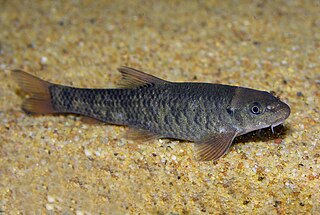
The Cyprinidae are the family of freshwater fish, collectively called cyprinids, that includes the carps, the true minnows, and their relatives. Also commonly called the "carp family", or "minnow family", Cyprinidae is the largest and most diverse fish family and the largest vertebrate animal family in general, with about 3,000 species of which only 1,270 remain extant, divided into about 370 genera. They range from about 12 mm to the 3-m Catlocarpio siamensis. The family belongs to the ostariophysian order Cypriniformes, of whose genera and species the cyprinids make up more than two-thirds. The family name is derived from the Ancient Greek kyprînos.

Mackerel is a common name applied to a number of different species of pelagic fish, mostly from the family Scombridae. They are found in both temperate and tropical seas, mostly living along the coast or offshore in the oceanic environment.

"Sardine" and "pilchard" are common names used to refer to various small, oily forage fish in the herring family Clupeidae. The term "sardine" was first used in English during the early 15th century and may come from the Mediterranean island of Sardinia, around which sardines were once abundant.

The Squaliformes are an order of sharks that includes about 126 species in seven families.

The Lamniformes are an order of sharks commonly known as mackerel sharks. It includes some of the most familiar species of sharks, such as the great white, as well as more unusual representatives, such as the goblin shark and megamouth shark.

Crappies are a genus, Pomoxis, of North American fresh water fish in the sunfish family Centrarchidae. Both species in this genus are popular pan fish.

The flagtails are a family (Kuhliidae) of perciform fish of the Indo-Pacific area. The family consists of several species in one genus, Kuhlia. Most are euryhaline and often found in brackish water, but the genus also includes species restricted to marine or fresh water.

The Gonostomatidae are a family of mesopelagic marine fish, commonly named bristlemouths, lightfishes, or anglemouths. It is a relatively small family, containing only eight known genera and 32 species. However, bristlemouths make up for their lack of diversity with numbers: Cyclothone, with 12 species, is thought to be the most abundant vertebrate genus in the world, numbering in the hundreds of trillions to quadrillions.

Lates is a genus of lates perches belonging to the family Latidae. The generic name is also used as a common name, lates, for many of the species.

Fundulus is a genus of ray-finned fishes in the superfamily Funduloidea, family Fundulidae. It belongs to the order of toothcarps (Cyprinodontiformes), and therein the large suborder Cyprinodontoidei. Most of its closest living relatives are egg-laying, with the notable exception of the splitfin livebearers (Goodeidae).

Clingfishes are fishes of the family Gobiesocidae, the only family in the order Gobiesociformes. These fairly small to very small fishes are widespread in tropical and temperate regions, mostly near the coast, but a few species in deeper seas or fresh water. Most species shelter in shallow reefs or seagrass beds, clinging to rocks, algae and seagrass leaves with their sucking disc, a structure on their chest.

The trumpetfishes are three species of highly specialized, tubular-elongated marine fishes in the genus Aulostomus, of the monogeneric family Aulostomidae. The trumpetfishes are members of the order Syngnathiformes, together with the seahorses and the similarly built, closely related cornetfishes.

Crenimugil is a genus of mullets found in coastal marine waters and rivers in the Indo-Pacific region.

Garra is a genus of fish in the family Cyprinidae. These fish are one example of the "log suckers", sucker-mouthed barbs and other cyprinids commonly kept in aquaria to keep down algae. The doctor fish of Anatolia and the Middle East belongs in this genus. The majority of the more than 140 species of garras are native to Asia, but about one-fifth of the species are from Africa.

Zaniolepis is a genus of scorpaeniform fish native to the eastern Pacific Ocean. Z. frenata is known to have been a source of food to the Native American inhabitants of San Nicolas Island off the coast of southern California, United States during the Middle Holocene.
Myroconger is the only genus of eels, the thin eels, in the family Myrocongridae. Very little is known about the group.

The Catostomidae are the suckers of the order Cypriniformes, with about 78 species in this family of freshwater fishes. The Catostomidae are almost exclusively native to North America. The only exceptions are Catostomus catostomus, found in both North America and Russia, and Myxocyprinus asiaticus found only in China. In the Ozarks they are a common food fish and a festival is held each year to celebrate them. Ictiobus cyprinellus can reach an age up to 112 years, making it the oldest known freshwater teleost.

Sicyases sanguineus is a species of amphibious marine clingfish in the family Gobiesocidae. It lives in the Southeast Pacific along the entire coast of Chile and southern Peru.

Chorisochismus dentex, the rocksucker or giant clingfish, is a species of clingfish found along the coast of southern Africa from Namibia to northern Natal, South Africa. It inhabits the intertidal and subtidal zones in shallow reefs and rock pools. This species is the only known member of its genus.

Cheilodactylus variegatus, the Peruvian morwong or bilagai, is a species of ray-finned fish found in the southeastern Pacific Ocean off the western coast of South America. Although traditionally included in the genus Cheilodactylus in family Cheilodactylidae, based on genetic and morphological analyses it belongs in the genus Chirodactylus in family Latridae.



















